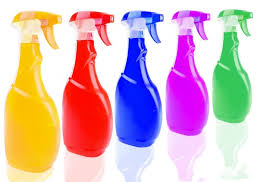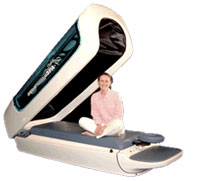When I was new to doing massage therapy, I had a habit of getting lost. Lost in the neck, lost on the back, lost in the space-time continuum. I’d glance up at my clock and see that I had spent 40 minutes massaging the back and I had 20 minutes to do the rest of the body. Or worse yet, 40 minutes just on the headache, and had 20 minutes to get hands on everything else!
And, learning point, most massage clients will be unhappy with that schedule. People will rarely complain, but they may decide not to come back. All my enthusiasm to erase that headache would cost me the opportunity to gain a client. Drat!
It happened often enough that I found a couple of solutions, which I will gladly share, and I  developed some hacks – ways to get the client to forget that I had just given an uneven massage.
developed some hacks – ways to get the client to forget that I had just given an uneven massage.
Fasten your seat belts.
Ask – Let the client decide – “Would you like me to spend all of our time today on your headache or do you also want a full-body massage?” Guess what the answer is 90 percent of the time…Full-body.
The clock – I drew a circle on an index card. The first 30 minutes was blocked in red, the next 10 in blue, the next 8 in yellow, etc. I hid the card behind my oil bottle, right next to my clock. The red zone was for the back and posterior arms. The next 10 minutes for posterior legs and feet. Eight minutes for anterior legs, eight for anterior arms. Four minutes for head and scalp.
Keep the card in view and practice, and you will run on time.
Okay, so what to do when space aliens have stolen your brain and you don’t have enough time to finish a full massage? When fudgsicles happen, make fudge!
Swoop – Big, long, slow, wasting Swedish effleurages. Three swoops to a limb will still trigger the parasympathetic nervous system. A timeless coma will result.
Hide – Stay in the room at the end of the massage and hold up the client’s robe in front of your face and conveniently stand in front of the clock. Offer to assist by holding the robe while they slip in arms and stumble out. “Let me help you with your robe.” It works.
I don’t recommend what one therapist did to me one day at an otherwise nice day spa. She carefully pointed out the clock to me to show that we were running on time. At the end of the session I got up and looked over at an empty space. She had removed the clock!
Category Archives: Tools of the Trade
Adding Magnesium to Massage
Got Magnesium?
Turns out that might be a great slogan for massage therapists – if they look both ways and proceed with caution.
Magnesium as a topical aid, and along with ingested and intravenous magnesium, has been used for a very long time in the treatment of muscular cramps and spasms.
Magnesium is the other side of the calcium formula. The movement of calcium ions out of a cell make muscles contract, while magnesium ions make muscle fibers relax. For people in the relax biz, magnesium could come in very handy.
And many folks seeking a massage are likely deficient in magnesium, possibly because we don’t eat enough of the sources – green leafy veggies, beans and bananas.
Should you add magnesium to a massage?
Well, let’s look at what’s out there.
Epsom salt soaks are our most traditional way of introducing topical magnesium. Many therapists make their own retail packages for client to buy or take home after a massage. A few drops of lavender or eucalyptus added to the salts and an organza bag, and the massage therapist has a take-home item for you.
But how many times do you see clients who cannot physically get in or out of a bathtub? Or don’t have a bathtub?
Epsom salt compresses are the next step down – but we all know compliance with this advice may well be zero. What client wants to wrangle wet and dry towels and plastic sheets?
Epsom salt lotions now readily available in most drugstores are another good solution. These do, however, use some pretty synthetic petrochemicals to get the hardy Epsom salts to stay in solution. Some clients don’t want that.
Oh dear, leave it to the healthy marketplace to find solutions.
Now when I head off to the vitamin health food store there’s a little group of magnesium topicals at the ready. And here’s the rub. Some don’t feel real good when applied to the skin.
My favorite one is magnesium oil spray, which is magnesium chloride. Yup, a salt. After a nice vigorous deep tissue massage on my professional test body, my spouse, I added a spritz to a tight shoulder. Immediately producing a stinging feeling described to me as rubbing salt on a wound. Run for the wet towels.
I like to use the magnesium oil spray on myself right after the shower. I tell clients to avoid it after shaving, to avoid the ouch factor.
After that experience with my professional test body I have never sprayed magnesium oil on an area post massage. I notice the makers were suggesting it as a massage oil additive, but after my experience with my unhappy test body, I’m not putting it on freshly massaged skin anytime soon.
Other forms of magnesium abound. I don’t go there with magnesium pills or drinks, largely because that’s not what I do. I massage, and telling someone to take something internally seems a bit out of my expertise area.
But for people who might need it for night cramps or diet deficiency I let them know it is out there, and they need to read and follow directions. Magnesium isn’t good for weak kidneys and in large amounts ingested magnesium is a super-dooper laxative!
Covering the Cradle
Some things about being a massage therapist are all about the details – the atmosphere, noise level, lighting, and yes the table linens.
Tools for Massage
Travel Tips Redoux!
 I love sharing travel tips with clients, as since they are classified top-secrets of the secret society Knights of the Massage Therapists, I want to share them with you.
I love sharing travel tips with clients, as since they are classified top-secrets of the secret society Knights of the Massage Therapists, I want to share them with you.The High Costs (and High Benefits) of Hands
I see these huge automatic water massage machines on E-bay all the time. Discounted to about $20,000. Maybe on a bad day, discounted to $10,000.
The ads say wonderful things about how great they are and how much money you will save by not having to have a massage therapist do the massage.
I read between the lines: Please, please, someone buy this huge thing and get it out of my office.
One always wonders if the future is going to be automated by something robotic and unfeeling. Something that will never develop carpal tunnel, come in late for a full day of appointments or forget to order oil.
There are plenty of massage gizmos, and the water massage tables were the only ones I feel come close to doing what we therapists do.
Only they are humongous, take 220 electric current, and are about as heavy as my car. They look like tanning beds on steroids and the lid closes down like a coffin.
Take heart, we haven’t been replaced yet. One electric bill, one repair bill and people want to get rid of these things.
Will swirling electric mitts, water jets or robots ever replace us? I don’t see it ever being possible to program the TLC of our chi into a machine.
Our humble little hands are safe. For now….
Wrapping Up a Massage with Tape





